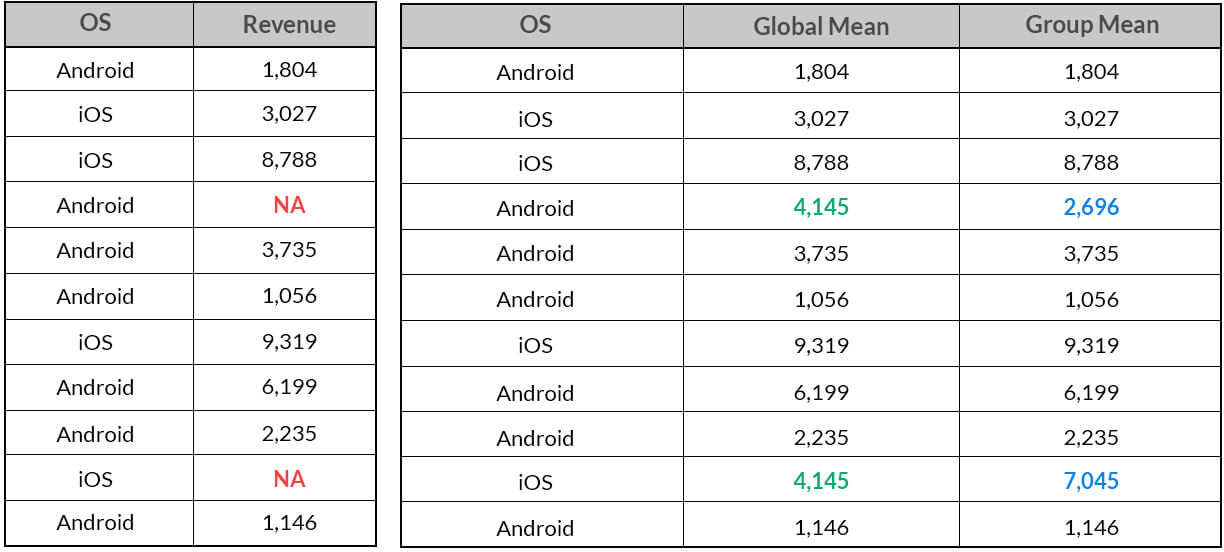One of most excruciating pain points during Data Exploration and Preparation stage of an Analytics project are missing values. How do you deal with missing values – ignore or treat them? The answer would depend on the percentage of those missing values in the dataset, the variables affected by missing values, whether those missing values are a part of dependent or the independent variables, etc. Missing Value treatment becomes important since the data insights or the performance of your predictive model could be impacted if the missing values are not appropriately handled. The 2 tables above give different insights. The inference from the table on the left with the missing data indicates lower count for Android Mobile users and iOS Tablet users and higher Average Transaction Value compared to the inference from the right table with no missing data. The inference from the data with missing values could adversely impact business decisions.
The 2 tables above give different insights. The inference from the table on the left with the missing data indicates lower count for Android Mobile users and iOS Tablet users and higher Average Transaction Value compared to the inference from the right table with no missing data. The inference from the data with missing values could adversely impact business decisions.
The best scenario is to get the actual value that was missing by going back to the Data Extraction & Collection stage and correcting possible errors during these stages. Generally, that won’t be the case and you will still be left with missing values.
Let’s look at some techniques to treat the missing values:
I. Deletion
Unless the nature of missing data is ‘Missing completely at random’, the best avoidable method in many cases is deletion.
a. Listwise: In this case, rows containing missing variables are deleted.
In the above case, the entire observation for User A and User C will be ignored for listwise deletion
b. Pairwise: In this case, only the missing observations are ignored and analysis is done on variables present.
In the above case, 2 separate sample data will be analyzed, one with the combination of User, Device and Transaction and the other with the combination of User, OS and Transaction. In such a case, one won’t be deleting any observation. Each of the samples will ignore the variable which has the missing value in it.
Both the above methods suffer from loss of information. Listwise deletion suffers the maximum information loss compared to Pairwise deletion. But, the problem with pairwise deletion is that even though it takes the available cases, one can’t compare analyses because the sample is different every time.
II. Imputation
a. Popular Averaging Techniques
Mean, median and mode are the most popular averaging techniques, which are used to infer missing values. Approaches ranging from global average for the variable to averages based on groups are usually considered.
For example: if you are inferring missing value for Revenue, you might assign the average defined by mean, median or mode to such missing value. You could also consider taking into account some other variables such as Gender of the User and/or the Device OS to calculate such an average to be assigned to the missing values.
Though you can get a quick estimate of the missing values, you are artificially reducing the variation in the dataset as the missing observations could have the same value. This may impact the statistical analysis of the dataset since depending on the percentage of missing observations imputed, metrics such as mean, median, correlation, etc may get affected. The above table shows the difference in imputed missing values of Revenue arrived by taking its global mean and mean based on which OS platform it belongs to.
The above table shows the difference in imputed missing values of Revenue arrived by taking its global mean and mean based on which OS platform it belongs to.
b. Predictive Techniques
Imputation of missing values from predictive techniques assumes that the nature of such missing observations are not observed completely at random and the variables chosen to impute such missing observations have some relationship with it, else it could yield imprecise estimates.
In the examples discussed earlier, a predictive model could be used to impute the missing values for Device, OS, Revenues. There are various statistical methods like regression techniques, machine learning methods like SVM and/or data mining methods to impute such missing values.
In the next article, we will take a look at an example where we shall build a predictive model by deletion, imputation by mean and imputation by a predictive model for missing observations and compare results of all three and try to arrive at a best possible approach.
Jacob Joseph 
Heads Data Science.Expert in AI, Data & Analytics and awarded 40 under 40 Data Scientists in India.
Free Customer Engagement Guides
Join our newsletter for actionable tips and proven strategies to grow your business and engage your customers.















































